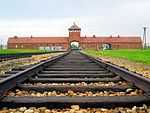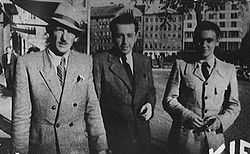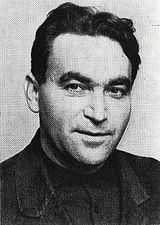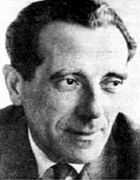Vrba–Wetzler report
 | |
| Location | Composed in Žilina, Slovakia, 25 April 1944 |
|---|---|
| Also known as | Auschwitz Protocols, Auschwitz Report, Auschwitz notebook |
| Participants | Rudolf Vrba and Alfréd Wetzler |
| Outcome | The report's publication caused world leaders to appeal for an end to the mass deportation of Hungary's Jews to Auschwitz. It ended on 9 July 1944, saving around 200,000 lives. |
| Website | Full text of the report |
The Vrba–Wetzler report, also known as the Auschwitz Protocols, the Auschwitz Report, and the Auschwitz notebook, is a 40-page document about the Auschwitz concentration camp in Nazi-occupied Poland during the Holocaust. It was written by hand or dictated in Slovak between 25 and 27 April 1944 by Rudolf Vrba and Alfréd Wetzler, two Slovak Jews who had escaped from Auschwitz on 10 April, then typed up by Oscar Krasniansky of the Slovak Jewish Council, who simultaneously translated it into German.
The report represents one of the first attempts to estimate the numbers being killed in the camp, and one of the earliest and most detailed description of the gas chambers. The first full English-language publication of the report was in November 1944 by the United States War Refugee Board. The original is kept in the War Refugee Board archives of the Franklin D. Roosevelt Presidential Library in New York.[2]
Auschwitz Protocols
The report is often referred to as the Auschwitz Protocols, although in fact the Protocols incorporated information from three reports, including the Vrba–Wetzler report.
The text of the report, under the title "German Extermination Camps—Auschwitz and Birkenau," was first published in full in English on 25 November 1944 by the Executive Office of the United States War Refugee Board.[3] The document combined the material from Vrba and Wetzler with two other reports, which came to be known jointly as the Auschwitz Protocols. They were submitted together in evidence at the Nuremberg Trials as document number 022-L.[2]
The Protocols included the seven-page report from Arnost Rosin and Czesław Mordowicz, who escaped from Auschwitz on 27 May 1944, and an earlier report, known as the "Polish Major's report," written by Jerzy Tabeau, who escaped on 19 November 1943 and compiled his report between December 1943 and January 1944.[4] This was presented in the Protocols as the 19-page "Transport (The Polish Major's Report)".[3] The full text of the English translation of the Protocols is in the archives of the War Refugee Board at the Franklin D. Roosevelt Presidential Library and Museum in New York.[5]
Contents
How it was written
The report was first written in Slovak by Vrba and Wetzler, beginning on 25 April 1944, and simultaneously translated into German by Oscar Krasniansky of the Slovakian Jewish Council in Žilina. It was written and re-written several times. Wetzler wrote the first part, Vrba the third, and the two wrote the second part together. They then worked on the whole thing together.[6] Oscar Krasniansky, an engineer and stenographer, translated it from Slovak into German with the help of Gisela Steiner.[6] They produced a 40-page report in German, which was completed by Thursday, 27 April. Vrba wrote that the report was also translated into Hungarian.[7] The original Slovak version of the report was not preserved.[6]
The report contained a detailed description of the geography and management of the camps, and of how the prisoners lived and died. It listed the transports that had arrived at Auschwitz since 1942, their place of origin, and the numbers "selected" for work or the gas chambers.[8] Kárný writes that the report is an invaluable historical document because it provides details that were known only to prisoners, most of whom died, including, for example, that discharge forms were filled out for prisoners who were gassed, indicating that death rates in the camp were actively falsified.[9]
Crematoria
It also contained sketches and information about the layout of the gas chambers. In a deposition for the trial of Adolf Eichmann in 1961, and in his book I Cannot Forgive (1964), Vrba said that he and Wetzler obtained the information about the gas chambers and crematoria from the Sonderkommando Filip Müller and his colleagues, who worked there. Müller confirmed Vrba's story in his Eyewitness Auschwitz (1979).[10] The report offered the following description:
.jpg)
At present there are four crematoria in operation at BIRKENAU, two large ones, I and II, and two smaller ones, III and IV. Those of type I and II consist of 3 parts, i.e.,: (A) the furnace room; (B) the large halls; and (C) the gas chamber. A huge chimney rises from the furnace room around which are grouped nine furnaces, each having four openings. Each opening can take three normal corpses at once and after an hour and a half the bodies are completely burned. This corresponds to a daily capacity of about 2,000 bodies. Next to this is a large "reception hall" which is arranged so as to give the impression of the antechamber of a bathing establishment. It holds 2,000 people and apparently there is a similar waiting room of the floor below. From there a door and a few steps lead down into the very long and narrow gas chamber. The walls of this chamber are also camouflaged with simulated entries to shower rooms in order to mislead the victims. This roof is fitted with three traps which can be hermetically closed from the outside. A track leads from the gas chamber to the furnace room.The gassing takes place as follows: the unfortunate victims are brought into hall (B) where they are told to undress. To complete the fiction that they are going to bathe, each person receives a towel and a small piece of soap issued by two men clad in white coats. They are then crowded into the gas chamber (C) in such numbers there is, of course, only standing room. To compress this crowd into the narrow space, shots are often fired to induce those already at the far end to huddle still closer together.
When everybody is inside, the heavy doors are closed. Then there is a short pause, presumably to allow the room temperature to rise to a certain level, after which SS men with gas masks climb on the roof, open the traps, and shake down a preparation in powder form out of tin cans labeled "CYKLON" "For use against vermin," which is manufactured by a Hamburg concern. It is presumed that this is a "CYANIDE" mixture of some sort which turns into gas at a certain temperature. After three minutes everyone in the chamber is dead. No one is known to have survived this ordeal, although it was not uncommon to discover signs of life after the primitive measures employed in the Birch Wood. The chamber is then opened, aired, and the "special squad" carts the bodies on flat trucks to the furnace rooms where the burning takes place. Crematoria III and IV work on nearly the same principle, but their capacity is only half as large. Thus the total capacity of the four cremating and gassing plants at BIRKENAU amounts to about 6,000 daily.[11]
Jean-Claude Pressac, a French specialist on the gas chambers, concluded in 1989 that, while the report was wrong about certain issues, it "has the merit of describing exactly the gassing process in type II/III Krematorien as from mid-March 1943. It made the mistake of generalizing internal and external descriptions and the operating method to Krematorien IV and V. Far from invalidating it, the discrepancies confirm its authenticity, as the descriptions are clearly based on what the witnesses could actually have seen and heard."[12] Auschwitz scholar Robert Jan van Pelt agreed, writing in 2002: "The description of the crematoria in the War Refugee Board report contains errors, but given the conditions under which information was obtained, the lack of architectural training of Vrba and Wetzlar [sic], and the situation in which the report was compiled, one would become suspicious if it did not contain errors. ... Given the circumstances, the composite "crematorium" reconstructed by two escapees without any architectural training is as good as one could expect."[13]
Impact
Distribution
| Part of a series of articles on the Holocaust |
| Vrba-Wetzler report timeline |
|---|
 Main railroad track into Auschwitz II-Birkenau. |
|
Timeline 1942
1943
March 1944
April 1944
May 1944
June 1944
July 1944
|
|
Key figures
|
|
Historians
|
|
Background
|
| Genocide portal |
The dates on which the report was passed to certain individuals has become a matter of importance within Holocaust historiography. This is partly because of the issue of whether the Hungarian government was aware of the gas chambers in Auschwitz before it facilitated the mass deportations, which began on 15 May, and partly because Vrba alleged that the report was not distributed quickly enough by Jewish leaders, particularly Rudolf Kastner of the Budapest Aid and Rescue Committee, and that lives were lost as a result.[14]
Israeli historian Yehuda Bauer writes that Oscar Krasniansky of the Jewish Council, who translated it into German from Slovak as Vrba and Wetzler were writing and dictating it, made conflicting statements about the report after the war. In the first, he said he handed the report to Kastner on 26 April during the latter's visit to Bratislava, but Bauer writes that the report was not finished until 27 April. In another statement, he said he gave it to Kastner on 28 April in Bratislava, but Hansi Brand, Kastner's lover and the wife of Joel Brand, said that Kastner was not in Bratislava until August. Bauer writes that it is nevertheless clear from Kastner's post-war statements that he had early access to the report, though perhaps not in April.[15] Randolph L. Braham writes that Kastner had a copy by 3 May when he paid a visit to Kolozsvár (Cluj), his home town.[16]
Kastner's reasons for not making the document public are unknown, but Vrba believed until the end of his life that Kastner withheld it in order not to jeopardize negotiations between the Aid and Rescue Committee and Adolf Eichmann, the SS officer in charge of the transport of Jews out of Hungary. Shortly after Vrba arrived in Slovakia from Auschwitz in April 1944, Eichmann proposed a deal to Kastner and others in Budapest that the Nazis would trade up to one million Hungarian Jews in exchange for 10,000 trucks and other goods from the Western Allies (see Joel Brand). The proposal came to nothing, but Kastner did obtain safe passage to Switzerland for 1,684 Jews on what became known as the Kastner train. Vrba believed that his report was suppressed in order not to damage these negotiations.[17]
Bauer writes that Kastner seems to have given a copy of the report in German to Géza Soós, a Hungarian Foreign Ministry official who ran a resistance group. Soós gave it to József Éliás, head of the Good Shepherd Mission, and Éliás's secretary, Mária Székely, translated it into Hungarian and prepared six copies. These copies made their way to various Hungarian and particularly Christian church officials, including Miklós Horthy's daughter-in-law.[18] Braham writes that this distribution occurred before 15 May.[19] According to Bauer, Ernő Pető, a member of the Budapest Jewish Council, said he gave copies to Horthy's son, the papal nuntius Angelo Rotta, and the finance minister Lajos Reményi-Schneller.[18]
The Jewish Council in Budapest did hand the report out to individuals, but told at least one person not to discuss it widely. The Hungarian biologist, George Klein, as a teenager in Budapest, was working for the Jewish Council as a junior secretary at the time. One day in late May or early June, his boss, Dr. Zoltán Kohn, gave him a carbon copy of the report, and told him that he should tell only his closest family and friends about it. He wrote that he told his uncle, a well-known physician, who "became so angry that he nearly hit me," and asked how he could believe such nonsense. It was the same with other relatives and friends. The older ones refused to believe it, while the younger ones believed it and wanted to act. When it came time for Klein to get on the train, he chose to run instead, and that saved his life.[20]
Deportations to Auschwitz continue

On 6 June 1944, the day of the Normandy landings, Arnošt Rosin and Czesław Mordowicz arrived in Slovakia, having escaped from Auschwitz on 27 May. Hearing about the Battle of Normandy and believing the war was over, they got drunk using dollars they had smuggled out of Auschwitz. As a result they were arrested for violating the currency laws, and spent time in jail before the Jewish Council paid their fines.[21] On 15 June, the men were interviewed by Oscar Krasniansky. They told him that, between 15 and 27 May, 100,000 Hungarian Jews had arrived at Birkenau, and that most were killed on arrival, apparently with no knowledge of what was about to happen to them. John Conway writes that Vrba and Wetzler concluded that their report had been suppressed.[1]
Report's arrival in Switzerland, press coverage
Braham writes that the report was taken to Switzerland by Florian Manoliu of the Romanian Legation in Bern, and given to George Mantello, a Jewish businessman from Transylvania who was working as the first secretary of the El Salvador consulate in Geneva. He writes that it was thanks to Mantello that the report received, in the Swiss press, its first wide coverage.[22] According to David Kranzler, Mantello asked for the help of the Swiss-Hungarian Students' League to make around 50 mimeographed copies of the Vrba–Wetzler and other Auschwitz reports (the Auschwitz Protocols), which by 23 June he had distributed to the Swiss government and Jewish groups. The students went on to make thousands of other copies, which were passed to other students and MPs.[23]
On 19 June, Richard Lichtheim of the Jewish Agency in Geneva, who had received a copy of the report from Mantello, wrote to the Jewish Agency in Jerusalem to say that they knew "what has happened and where it has happened," and reported the Vrba–Wetzler figure that 90 per cent of Jews arriving at Birkenau were being killed.[24] Vrba and Oscar Krasniasnky met Vatican Swiss legate Monsignor Mario Martilotti at the Svätý Jur monastery in Bratislava on 20 June. Martilotti had seen the report and questioned Vrba about it for six hours.[25] According to Bauer, Martilotti said he was travelling to Switzerland the next day, and on 25 June the Pope appealed to Horthy to stop further suffering. Bauer writes that, as of 2002, the Vatican had not made its archives for the period available, and so the connection, if any, between the Vrba–Wetzler report and the appeal to Horthy remains unclear.[26]
As a result of the coverage given to the report in the Swiss press, details began to appear elsewhere, including in The New York Times on 4 June, the BBC World Service on 15 June, and The New York Times on 20 June, which carried a 22-line story that 7,000 Jews had been "dragged to gas chambers in the notorious German concentration camps at Birkenau and Oświęcim [Auschwitz]." Daniel Brigham, the New York Times correspondent in Geneva, published a longer story on 3 July, "Inquiry Confirms Nazi Death Camps," and on 6 July a second, "Two Death Camps Places of Horror; German Establishments for Mass Killings of Jews Described by Swiss."[27]
Deportations halted
Braham writes that, shortly after the Swiss coverage, several appeals were made to Horthy, including by the Swiss government, President Franklin D. Roosevelt, Gustaf V of Sweden and, on 25 June, Pope Pius XII, possibly after Martilotti passed on the report.[28] On 26 June, Richard Lichtheim of the Jewish Agency in Geneva sent a telegram to England calling on the Allies to hold members of the Hungarian government personally responsible for the killings. The cable was intercepted by the Hungarian government and shown to Prime Minister Döme Sztójay, who passed it to Horthy. Horthy ordered an end to the deportations on 7 July, and they stopped two days later.[29]
Hitler was infuriated by Horthy's decision and instructed the Nazi representative to Hungary, Edmund Veesenmayer, to relay an angry message to the Admiral.[30] Hitler's ultimatum to Horthy read: "The Führer expects that the Hungarian Government will take measures against the Budapest Jewry without any further delay...[and would not tolerate anything] that could or would weaken their fighting spirit or that could possibly stab the fighting soldiers in the back."[31]
Horthy resisted Hitler's threats and Budapest's 200,000-260,000 Jews were temporarily spared from being deported to Auschwitz until the pro-Nazi Arrow Cross Party seized power in Hungary in a coup on 15 October 1944.[32] Henceforth, the deportations of some of Budapest's Jews to German death and labour camps resumed but, by this time, the heavy diplomatic involvement of the Swedish, Swiss, Spanish and Portuguese embassies at Budapest, as well as that of the Vatican's papal nuncio, Angelo Rotta, saved tens of thousands of the city's Jews from being expelled and/or murdered.[33] The Swedish delegation under Raoul Wallenberg saved 70,000 Jews until the arrival of the Red Army in Budapest in January 1945.[34]
Notes
- ↑ 1.0 1.1 Conway (undated)
- ↑ 2.0 2.1 Conway (2002), Appendix I, p. 292–293, footnote 3.
- ↑ 3.0 3.1 Gilbert (1989), p. 305
- Kárný writes that the full report was published on 25 November 1944, the same day the last 13 prisoners, all women, were gassed or shot in crematorium II in Auschwitz-Birkenau (Kárný (1998), p. 564).
- ↑ Szabó (2011), pp. 90–91
- ↑ vanden Heuvel (2011), p. v
- ↑ 6.0 6.1 6.2 This description of how the report was written was recorded in the first post-war Slovak edition, Oswiecim, hrobka štyroch miliónov ľudí ("Auschwitz, the tomb of four million"), Bratislava, 1946, p. 74. Wetzler also confirmed it in a letter to Miroslav Kárný, dated April 14, 1982. See Kárný (1998), p. 564, footnote 5.
- ↑ Vrba (2002), pp. 402–403
- ↑ Karny (1998), p. 554; van Pelt (2011), p. 123.
- ↑ Kárný (1998), p. 555
- ↑ van Pelt (2002), p. 149
- ↑ Świebocki (1997), pp. 218, 220, 224; also see "The Vrba-Wetzler Report", part 2.
- Note: Świebocki (1997), in his reproduction of the Vrba–Wetzler report, presents this material without paragraph breaks. For ease of reading, two paragraph breaks have been inserted into the text above.
- ↑ Pressac (1989), p. 464
- ↑ van Pelt (2002), p. 151
- ↑ For Vrba's allegations, see Braham (2000), p. 276, footnote 50
- ↑ Bauer (2002), p. 231
- ↑ Braham (2000), p. 95
- ↑ Vrba (2002), pp. 419–420
- ↑ 18.0 18.1 Bauer (1994), p. 157; Braham (2000), p. 95
- ↑ Braham (2000), p. 97
- ↑ Klein (2011), pp. 258-263.
- ↑ Vrba (2002), p. 406
- ↑ Braham (2000) pp. 95, 214
- ↑ Kranzler (2000), pp. 98-99
- ↑ van Pelt (2002), p. 152
- That Lichtheim received the report from Mantello, see Kranzler (2000), p. 104. Kranzler places the cable to Jerusalem on 26 June, and writes that Lichtheim referred in the cable to 12,000 Jews being deported daily from Budapest.
- ↑ Kárný (1998), pp. 556–557
- ↑ Bauer (2002), p. 230
- ↑ van Pelt (2002), pp. 153–154; Brigham (6 July 1944).
- ↑ Braham (2000), pp. 95, 214; Bauer (2002), p. 230
- ↑ Rees (2006), pp. 242–243
- ↑ Dwork and van Pelt (2002), p. 314
- ↑ German ultimatum to Horthy, 17 July 1944, see Lévai (1987), p. 125
- ↑ Dwork and van Pelt (2002), p. 314, say the figure was 260,000 Jews in Budapest.
- ↑ Dwork & van Pelt, p. 317
- ↑ Dwork & van Pelt, p. 318
References
- Bauer, Yehuda (1994). Jews for Sale? Nazi–Jewish Negotiations 1933–1945. Yale University Press.
- _________ (2002). Rethinking the Holocaust. Yale University Press.
- Braham, Randolph L. (2000). The Politics of Genocide: The Holocaust in Hungary. Wayne State University Press; first published in 1981 in two volumes.
- _________ (2011). "Hungary: The Controversial Chapter of the Holocaust," in Randolph L. Braham and William vanden Heuvel. The Auschwitz Reports and the Holocaust in Hungary. Columbia University Press.
- Brigham, Daniel T. (6 July 1944). "Two Death Camps Places of Horror; German Establishments for Mass Killings of Jews Described by Swiss", The New York Times.
- Conway, John (2002). "The Significance of the Vrba-Wetzler Report on Auschwitz-Birkenau," in Vrba, Rudolf. I escaped from Auschwitz, Appendix I, pp. 290–324.
- _________ (undated). "The First Report about Auschwitz", Museum of Tolerance, Simon Wiesenthal Center, Annual 1, Chapter 7.
- Dwork, Debórah and Van Pelt, Robert Jan (2002). Holocaust: A History. W.W. Norton & Company
- Gilbert, Martin (1989). "The Question of Bombing Auschwitz," in Michael Robert Marrus. The Nazi Holocaust: The End of the Holocaust. Part 9. Walter de Gruyter.
- Hilberg, Raul (2003). The Destruction of the European Jews. Yale University Press; first published 1961.
- Kárný, Miroslav (1998). "The Vrba and Wetzler report", in Berenbaum and Gutman, op cit.
- Klein, George (2011). "Confronting the Holocaust: An Eyewitness Account," in Braham and vanden Heuvel, op cit.
- Kranzler, David (2000). The Man Who Stopped the Trains to Auschwitz: George Mantello, El Salvador, and Switzerland's Finest Hour. Syracuse University Press.
- Lévai, Jenö (1987). Eichmann in Hungary: Documents. Howard Fertig.
- Pressac, Jean-Claude (1989). Auschwitz: Technique and operation of the gas chambers. The Beate Klarsfeld Foundation.
- Rees, Laurence (2006). Auschwitz: A New History. PublicAffairs.
- Świebocki, Henryk (ed.) (1997). London has been informed. Reports by Auschwitz Escapees. Auschwitz-Birkenau State Museum.
- Szabó, Zoltán Tibori (2011). "The Auschwitz Reports: Who Got Them, and When?" in Randolph L. Braham and William vanden Heuvel. The Auschwitz Reports and the Holocaust in Hungary. Columbia University Press.
- van Pelt, Robert Jan (2002). The Case for Auschwitz: Evidence from the Irving Trial. Indiana University Press.
- _________ (2011). "When the Veil was Rent in Twain," in Randolph L. Braham and William vanden Heuvel. The Auschwitz Reports and the Holocaust in Hungary. Columbia University Press.
- Vrba, Rudolf (2002). I Escaped from Auschwitz. Barricade Books, 2002. First published as I Cannot Forgive by Sidgwick and Jackson, Grove Press, 1963; also published as Escape from Auschwitz:
Further reading
- "The Full-Text of the Vrba Wetzler Report", The Holocaust Education & Archive Research Team
- "The Vrba Wetzler Report", The Holocaust History Project.
- Gutman, Yisrael (ed.) (1990). Encyclopaedia of the Holocaust. Macmillan Publishing Company.
- Lanik, Jozef (pseudonym of Alfred Wetzler) (1963). Co Dante nevidel. Bratislava.
- _________ (1967). Was Dante nicht sah. Frankfurt.
- Wetzler, Alfred (2007). Escape from Hell: The True Story of the Auschwitz Protocol. Berghahn Books.

